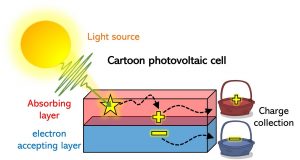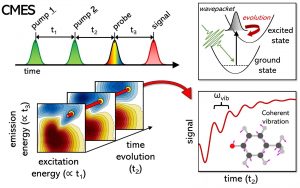For thousands of years, scientists and engineers have been trying to harness one of the most widely available and sustainable sources of energy: the sun. Ancient humans used the sun to make fire and light their homes with mirrors. Today, photovoltaic (PV) cells collect sunlight and convert it into electricity that we can use in our homes. While solar technologies have evolved tremendously since their conception, their efficiency in harvesting and repurposing energy from the sun remains a bottleneck in their development.
There are a daunting number of factors that govern the efficiency of a PV cell. Many key characteristics can be traced back to fundamental chemical properties of the materials that compose the solar cell. Therefore, building a thorough understanding of how material properties impact solar energy conversion and leveraging this knowledge to guide the design of highly efficient PV devices is imperative.

One approach to examine the chemical properties and behaviors of photovoltaic materials is to watch them in real-time as they facilitate energy conversion. When light is shined on a solar cell, the absorbing material within the cell collects some of the light, leaving one or more molecules in an excited state, as represented by the glowing yellow star in the above image. This deposited energy must then migrate through the device to a region where it can be converted into free charge carriers (electrons and holes) that are ready for collection. Once collected, they can be used to generate electricity.
These processes happen on extremely short timescales, sometimes on the order of a millionth of a billionth of a second! The molecules are getting excited by the sun and separating into different charges billions of times in the blink of an eye. Adding additional complexity, sunlight covers a broad energy spectrum ranging from high-energy ultraviolet rays to low-energy infrared light.

Due to the vast ranges of relevant wavelengths of light and time scales, several observational perspectives are required to form a complete picture of efficient energy conversion. The picture above illustrates the added insight that accompanies viewing a landscape not only straight on, but also from the side where forest and mountain layers can be distinguished more clearly.
Similar to the advantages of viewing a landscape in multiple dimensions, the fundamental properties of efficient PV materials can be revealed using coherent multidimensional electronic spectroscopy (CMES), which is a technique that can tell us about the energy absorbed by a solar cell by light and how follow the energy absorbed as the material reacts over time. Scientists use lasers so they don’t have to rely on the sun shining for their experiments. As portrayed by the green oscillatory arrow in the cartoon PV schematic below, CMES uses pulsed laser light instead of sunlight to mimic the effects of incident sunlight while affording high time resolution.
The same way that we can change our perspective to view the mountain differently, we can change our perspective with our spectroscopy techniques. To generate our perspective slices, we use three laser pulses. The first two pulses “pump” the system of interest with energy and the third “probes” the state of the system and induces the emission of a signal light wave. By varying t2, the time delay, the response of the PV material to the pump pulses can be tracked as a function of time. Moreover, varying the t1 and t3 time delays and using a mathematical tool called Fourier transformation reveals how the molecular response is dependent on the energy being put in (bottom left of the figure below).

The rich information across time and energy dimensions afforded by CMES allows researchers to form a detailed picture of the dynamics of energy absorption, migration, and conversion to harvestable charge carriers within PV materials and devices. In addition, even more fundamental insight can be gained by examining oscillations in the CMES signals as a function of t2. The properties and evolution of these oscillations can unveil how coherence between quantum states impact light harvesting processes at the molecular scale in PV materials. While only recently developed, many research groups today are using this approach to examine how vibrations can facilitate coherent transport of energy and charge in promising synthetic materials.
Contributors:
Jonathan Schultz, Kaydren Orcutt